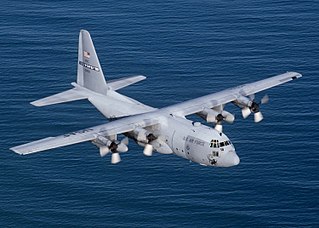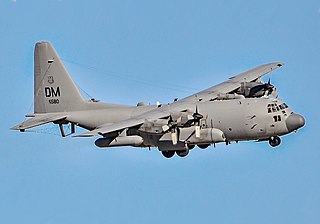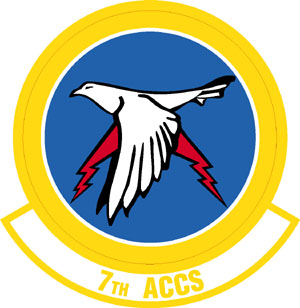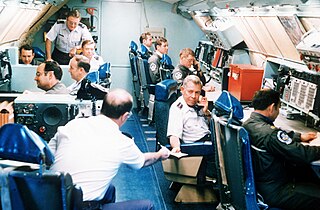
The Lockheed C-130 Hercules is an American four-engine turboprop military transport aircraft designed and built by Lockheed. Capable of using unprepared runways for takeoffs and landings, the C-130 was originally designed as a troop, medevac, and cargo transport aircraft. The versatile airframe has found uses in other roles, including as a gunship (AC-130), for airborne assault, search and rescue, scientific research support, weather reconnaissance, aerial refueling, maritime patrol, and aerial firefighting. It is now the main tactical airlifter for many military forces worldwide. More than 40 variants of the Hercules, including civilian versions marketed as the Lockheed L-100, operate in more than 60 nations.

The Boeing E-6 Mercury is an airborne command post and communications relay based on the Boeing 707-300. The original E-6A manufactured by Boeing's defense division entered service with the United States Navy in July 1989, replacing the EC-130Q. This platform, now modified to the E-6B standard, conveys instructions from the National Command Authority to fleet ballistic missile submarines, a mission known as TACAMO.

TACAMO is a United States military system of survivable communications links designed to be used in nuclear warfare to maintain communications between the decision-makers and the triad of strategic nuclear weapon delivery systems. Its primary mission is serving as a signals relay, where it receives orders from a command plane such as Operation Looking Glass, and verifies and retransmits their Emergency Action Messages (EAMs) to US strategic forces. As it is a dedicated communications post, it features the ability to communicate on virtually every radio frequency band from very low frequency (VLF) up through super high frequency (SHF) using a variety of modulations, encryptions and networks, minimizing the likelihood an emergency message will be jammed by an enemy. This airborne communications capability largely replaced the land-based extremely low frequency (ELF) broadcast sites which became vulnerable to nuclear strike.

The Lockheed Martin EC-130 series comprises several slightly different versions of the Lockheed C-130 Hercules that have been and continue to be operated by the U.S. Air Force and, until the 1990s, the U.S. Navy.

The Boeing E-4 Advanced Airborne Command Post (AACP), the current "Nightwatch" aircraft, is a strategic command and control military aircraft operated by the United States Air Force (USAF). The E-4 series are specially modified from the Boeing 747-200B for the National Emergency Airborne Command Post (NEACP) program. The E-4 serves as a survivable mobile command post for the National Command Authority, namely the President of the United States, the Secretary of Defense, and successors. The four E-4Bs are operated by the 1st Airborne Command and Control Squadron of the 595th Command and Control Group located at Offutt Air Force Base, near Omaha, Nebraska. An E-4B when in action is denoted a "National Airborne Operations Center" and has been nicknamed the "Doomsday plane".

The EC-130H Compass Call is an electronic attack aircraft flown by the United States Air Force. Based on the Lockheed C-130 Hercules, the aircraft is heavily modified to disrupt enemy command and control communications, perform offensive counterinformation operations, and carry out other kinds of electronic attacks. Planned upgrades will add the ability to attack early warning and acquisition radars. Based at Davis-Monthan AFB in Arizona, EC-130Hs can be deployed worldwide at short notice to support U.S. and allied tactical air, surface, and special operations forces.

The Lockheed HC-130 is an extended-range, search and rescue (SAR)/combat search and rescue (CSAR) version of the C-130 Hercules military transport aircraft, with two different versions operated by two separate services in the U.S. armed forces.
Doomsday plane is an unofficial denomination of a class of aircraft which is used as an airborne command post in an event of nuclear war, disaster or other large scale conflict that threatens key military and government infrastructure.

The Boeing EC-135 is a retired family of command and control aircraft derived from the Boeing C-135 Stratolifter. During the Cold War, the EC-135 was best known for being modified to perform the Looking Glass mission where one EC-135 was always airborne 24 hours a day to serve as flying command post for the Strategic Air Command in the event of nuclear war. Various other EC-135 aircraft sat on airborne and ground alert throughout the Cold War, with the last EC-135C being retired in 1998. The EC-135N variant served as the tracking aircraft for the Apollo program.

Looking Glass is the historic code name for an airborne command and control center operated by the United States. In more recent years it has been more officially referred to as the ABNCP. It provides command and control of U.S. nuclear forces in the event that ground-based command centers have been destroyed or otherwise rendered inoperable. In such an event, the general officer aboard the Looking Glass serves as the Airborne Emergency Action Officer (AEAO) and by law assumes the authority of the National Command Authority and could command execution of nuclear attacks. The AEAO is supported by a battle staff of approximately 20 people, with another dozen responsible for the operation of the aircraft systems. The name Looking Glass, which is another name for a mirror, was chosen for the Airborne Command Post because the mission operates in parallel with the underground command post at Offutt Air Force Base.

The 193rd Special Operations Wing is a unit of the Pennsylvania Air National Guard, stationed at Harrisburg Air National Guard Base, Middletown, Pennsylvania. The wing is gained by the Commonwealth of Pennsylvania when in a "state" status, as well as by the United States Air Force and Air Force Special Operations Command in its Federal capacity as part of the Air National Guard. The wing was organized as a group, the 193rd Tactical Electronic Warfare Group. Although it has never been mobilized as a unit, most of its equipment and personnel have been individually called up to serve in Southeast Asia and in Desert Storm.

The 4th Special Operations Squadron is part of the 1st Special Operations Wing at Hurlburt Field, Florida. It operates Lockheed AC-130J aircraft providing special operations capabilities.

The Lockheed Martin C-130J Super Hercules is a four-engine turboprop military transport aircraft. The C-130J is a comprehensive update of the Lockheed C-130 Hercules, with new engines, flight deck, and other systems.

The 7th Expeditionary Airborne Command and Control Squadron is part of the 379th Air Expeditionary Wing at Al Udeid Air Base, Qatar. It operates the E-8 Joint STARS aircraft, conducting airborne command and control missions. The squadron has performed the airborne command and control mission since 1968, when it was activated in Vietnam. In 1985, the squadron was consolidated with three earlier units: The 7th Ferrying Squadron, which helped deliver aircraft to the Soviet Union from 1942 until 1944; the 7th Combat Cargo Squadron, which performed combat airlift missions in the Southwest Pacific Theater from 1944 until V-J Day, then became part of the Occupation Forces in Japan until inactivating in 1948; and the 7th Air Transport Squadron, Special, which provided airlift support for the United States' special weapons program from 1954 to 1966.

The Airborne Launch Control System (ALCS) provides a survivable launch capability for the United States Air Force's LGM-30G Minuteman III intercontinental ballistic missile (ICBM) force. The ALCS is operated by airborne missileers from Air Force Global Strike Command's (AFGSC) 625th Strategic Operations Squadron (STOS) and United States Strategic Command (USSTRATCOM). The system is located on board the United States Navy's E-6B Mercury, which serves as USSTRATCOM's "Looking Glass" Airborne Command Post (ABNCP). The ALCS crew is integrated into the ABNCP battle staff and is on alert around the clock.

The United States Air Force's 2d Airborne Command and Control Squadron was an airborne command and control unit located at Offutt Air Force Base, Nebraska. The squadron was an integral part of the United States' Post Attack Command and Control System, performing the Operation Looking Glass mission with the Boeing EC-135 aircraft.

Strategic Communications Wing 1 is a nuclear command and control wing of the United States Navy. Its TACAMO mission provides airborne communications links to nuclear missile units of United States Strategic Command. It is located at Tinker Air Force Base, Oklahoma.

Fleet Air Reconnaissance Squadron 3 (VQ-3), nicknamed the Ironmen, is a naval aviation squadron of the United States Navy based at Tinker Air Force Base, Oklahoma. The squadron flies the Boeing E-6B Mercury airborne command post and communications relay aircraft. It is part of the Navy's TACAMO community, whose mission is to enable the President of the United States and the Secretary of Defense to directly communicate with U.S. submarines, bombers, and missile silos during a nuclear war.

Fleet Air Reconnaissance Squadron 4 (VQ-4), nicknamed the Shadows, is a naval aviation squadron of the United States Navy based at Tinker Air Force Base, Oklahoma. The squadron flies the Boeing E-6B Mercury airborne command post and communications relay aircraft. It is part of the U.S. Navy's TACAMO community, whose mission is to enable the President of the United States and the Secretary of Defense to directly communicate with U.S. submarines, bombers, and missile silos during a nuclear war.
The Survivable Airborne Operations Center (SAOC) is a United States Air Force program to develop a replacement for the E-4 National Airborne Operations Center (NAOC), a strategic command-and-control military aircraft used as a mobile command post for the National Command Authority in emergency situations. The current E-4 platforms were built in the 1970s, the airframes are reaching the end of their operational lifespans and support costs are increasing. Because of this, in 2019, the USAF began a program to develop a new platform. This program will take several years to complete, and the E-4s will continue to fulfill the role in the meantime.
















